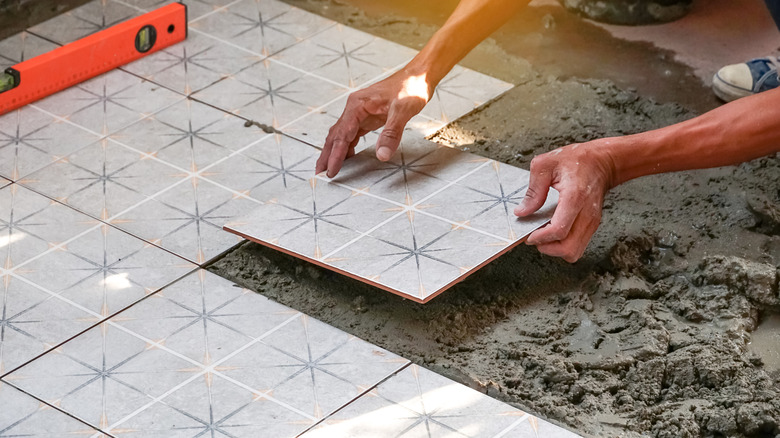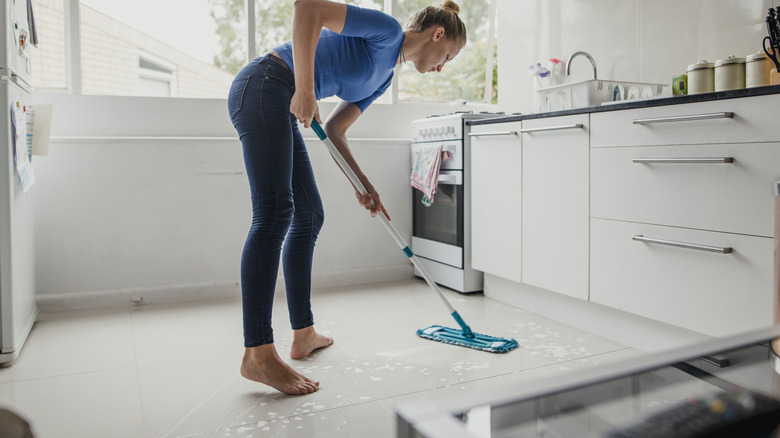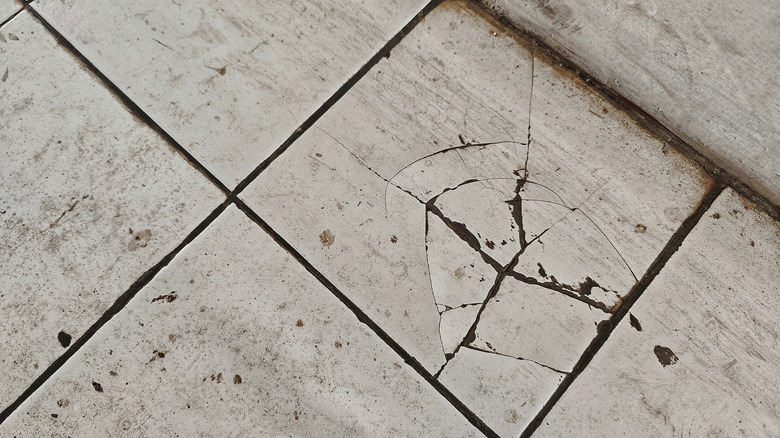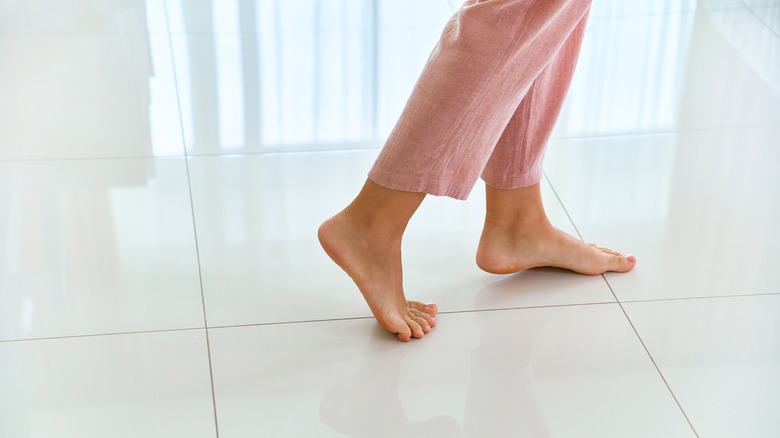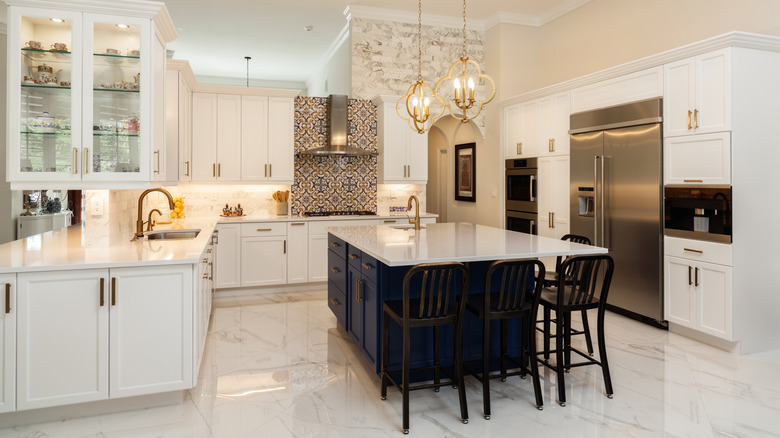The Best & Worst Tile Flooring To Choose For Your Kitchen
Fact: Tiles are among the best flooring options for the kitchen. Unlike hardwood floors, for instance, most tiles often stand up to all kinds of stains and scratches and aren't easily damaged by water leaks. That means no worrying about cupping and crowning, some of the earliest signs that water is damaging your hardwood floor. Plus, although grout lines need more attention, tiles are easier to clean. Typically, all you need is a quick wipe with a rag. The truth is, you should spend time cooking — or admiring your dinnerware sets — not strenuously scrubbing your floor with every drop and spill. Does this mean you should pick any tile out there? Far from it. Despite their general overall durability, not all kitchen floor tiles are created equal.
For example, some types of tiles are easy to install. Others require much more effort and skill. Similarly, some types of tiles are harder and more durable. Others tend to crack and break easily. Other factors to consider include the look and feel you're aiming for, your desired level of comfort when standing, and porosity. You don't want a tile that water and other stains can penetrate. As a homeowner, therefore, you'll need to carefully weigh these factors and pick a kitchen floor tile that will serve you well. That said, considering most factors, porcelain tiles could be one of the best flooring options for your kitchen. On the flip side, natural stone is porous and easily soaks up moisture and stains.
Natural stone tiles are prone to staining
While kitchen floor tiles are typically easy to clean, the ease of cleaning is not uniform across the board. To be easy to clean, a kitchen floor tile should be made from a non-porous material — one that food debris and stains can't easily penetrate. Remember, you'll be handling a lot of spills. Keep in mind that natural stone tiles are among the most porous, with limestone and sandstone particularly more so. For this reason, it is recommended to seal stone tiles at the time of installation properly and subsequently use a quality stone sealer every two or so years. Ceramic floor tiles are also porous and often have to be glazed to resist spills and splashes.
The best kitchen floor tile for cleaning is porcelain. While ceramic tiles are mainly slabs of clay fired at high temperatures, porcelain tiles include sand (in addition to clay and other materials), a combination that produces a denser and less porous version of regular ceramic.
Porcelain impresses when it comes to durability
Even if you have stacked a lot of cash in your bank account, you want to spend it on something other than replacing and repairing unsightly chips in your floor tiles every other year. When choosing a kitchen floor tile, it's wise to go for a durable material, something that can remain unscathed 20 years down the line or more. Remember, you're looking for a tile for your kitchen floor, not your bedroom. This means the material should handle a lot of foot traffic and resist heat and temperature variations. One of the most durable options for kitchen floor tile is natural stone, though you could face issues with stains and discoloration. Porcelain, on the other hand, is often just as hardwearing and can see you through many years.
On the flip side, while ceramic floor tiles are hard, they can't hold a candle to natural stone or porcelain. Ceramic floor tiles can last for at least 20 years, of course, and many more with scrupulous maintenance, but porcelain takes the cake if your priority is durability. While it's typically more cost-effective and easy to install, you should also avoid vinyl flooring if you're going for longevity. Luxury vinyl tile, or LVT, doesn't perform at the top level, and thinner options might need to be replaced after only five years. Vinyl tiles can fade, scratch, and even melt.
Glossy ceramic tile can be uncomfortable and slippery
You'll be standing in the kitchen for hours, and you don't want to feel that you're walking on ice. You also don't want a surface where you can slip and fall, even break a bone. Of course, you can add a rug to your kitchen to create more cushion and traction. However, the best strategy is to have a floor tile that is safe and comfortable. If you are exclusively looking for comfort or safety, choose a luxury vinyl tile because it's the best kitchen floor type for comfort. Vinyl tiles are warmer, feel safer, and are more comfortable to stand on.
On the flip side, don't go for a ceramic floor tile if your top priority is comfort and safety. Ceramic tiles are smooth, hard, and can be quite slippery when wet. Glazed ceramic tiles are particularly risky. Similarly, because it is a close cousin of ceramic, porcelain can just be as slippery. Still, you can opt for the less slippery matte tiles — whether porcelain or ceramic — or consider buying tiles that meet industry specifications for slipperiness, a minimum of 0.42 on the Dynamic Coefficient of Friction (DCOF) scale.
LVT is great if you're on a budget
Vinyl tiles may not be the most durable, but they are among the best kitchen floor tiles if you're on a budget. The main advantage of vinyl tiles is that they require just a few specialty tools to install. Similarly, vinyl tiles typically don't require lots of additional materials. They are quick to install and, hence, the dream of any DIYer. Installing vinyl tile costs between $1.50 and $2 per square foot. The only other material that compares favorably with vinyl in affordability is linoleum, which costs around $2 per square foot if you opt for a water-resistant option. Ceramic tiles are also big-time savers. You can expect to pay as little as $0.50 per square foot for plain ceramic tile, although this excludes additional costs such as professional installation and underlayment.
On the other side of the cost spectrum are porcelain tiles, which cost between $9 and $50 per square foot, and natural stone, which costs between $10 and $50. Of course, glass is among the most expensive tiling options, but it is simply not acceptable on a kitchen floor.
Real stone tiling is a fashionable and luxurious choice
The best kitchen floor tile for appearance is natural stone. Besides providing an unbeatable aesthetic appeal, natural stone comes with a touch of sophistication and class — and a range that can be customized to fit a variety of design styles. Moreover, the fact that one stone tile is different from another can make the whole space look unique and beautiful. No wonder natural stone, depending on whether it's marble, granite, slate, or travertine, boats some of the highest returns on investment out there. Porcelain tiles also look fabulous and can mimic natural stone. However, they are typically more homogenous and, hence, lack the unique character of natural stone. Through-bodied porcelain is particularly a great choice, especially for how it masks chips and scratches. Next in the pecking order of beauty is ceramic followed by vinyl.
Of course, there are several other factors to consider, including the size of your tiles (large tiles can make a kitchen appear bigger), the color of the tiles (check out the best kitchen tile colors), and how the tiles will match the cabinets. In the end, while porcelain is a fantastic floor tile option for the kitchen, there are plenty of other materials worth considering depending on your priorities.
